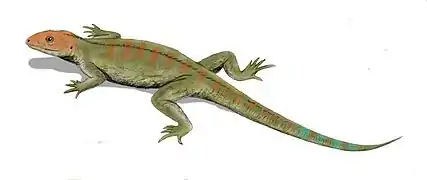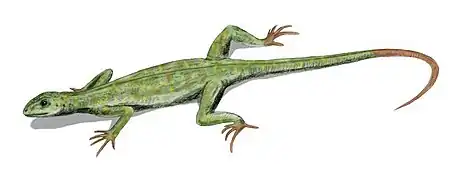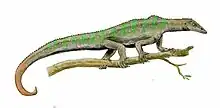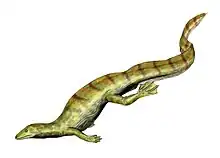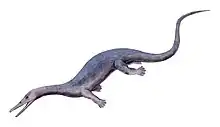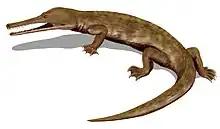| Araeoscelis Temporal range: Artinskian | |
|---|---|
 | |
| Life restoration | |
| Scientific classification | |
| Domain: | Eukaryota |
| Kingdom: | Animalia |
| Phylum: | Chordata |
| Class: | Reptilia |
| Order: | †Araeoscelidia |
| Family: | †Araeoscelidae |
| Genus: | †Araeoscelis Williston 1910 |
| Type species | |
| Araeoscelis gracilis Williston 1910 | |
| Species | |
| |
| Synonyms | |
| |
Araeoscelis (from Greek: αραιά araiá, 'thin' and Greek: σκελίς skelís, 'ribs of beef')[1] is an extinct genus of reptile, and potentially one of the earliest diapsids (a study from 2022 argued for a placement as a stem-amniote).[2] Fossils have been found in the Nocona, Arroyo and Waggoner Ranch Formations in Texas, dating to the Early Permian. Two species have been described, A. casei and A. gracilis.[3]
Description

Araeoscelis was around 60 centimetres (2.0 ft) long, and superficially resembled a modern lizard. It differed from earlier forms, such as Petrolacosaurus, in that its teeth were larger and blunter; possibly they were used for cracking insect carapaces.[4]
Unlike its close relatives, which exhibit the two pairs of skull openings characteristic of diapsids, in Araeoscelis the lower pair of temporal fenestrae were closed with bone, resulting in a euryapsid condition. This would have made the skull more solid, presumably allowing a more powerful bite.[4]
Ichnology
Footprints found in Nova Scotia have been attributed to Araeoscelis or a close relative.[3]
References
- ↑ Colbert, Edwin H. (Edwin Harris); Knight, Charles Robert (1951). The dinosaur book : the ruling reptiles and their relatives. New York : Published for the American Museum of Natural History by McGraw-Hill. p. 145. Retrieved 17 December 2022.
- ↑ Simões, Tiago R.; Kammerer, Christian F.; Caldwell, Michael W.; Pierce, Stephanie E. (2022-08-19). "Successive climate crises in the deep past drove the early evolution and radiation of reptiles". Science Advances. 8 (33). doi:10.1126/sciadv.abq1898. ISSN 2375-2548. PMC 9390993. PMID 35984885.
- 1 2 Dixon, Dougal (2015). The Complete Illustrated Encyclopedia of Dinosaurs. London: Hermes House.
- 1 2 Palmer, D., ed. (1999). The Marshall Illustrated Encyclopedia of Dinosaurs and Prehistoric Animals. London: Marshall Editions. p. 82. ISBN 1-84028-152-9.
Further reading
- Carroll, Robert L. (1988). Vertebrate Paleontology and Evolution. New York: W.H. Freeman and Co. ISBN 9780716718222.
- Benton, Michael J. (2000). Vertebrate Paleontology (2nd ed.). Oxford: Blackwell Science.
- Simon and Schuster (1999). The Simon & Schuster Encyclopedia of Dinosaurs and Prehistoric Creatures (1st ed.). Great Britain: Marshall Publishing. ISBN 0-684-86411-8.

